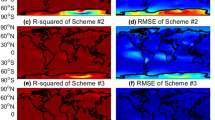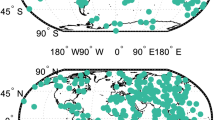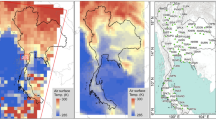Abstract
Weighted mean temperature (Tm) acts as a vital parameter in an extensive range of applications, such as atmospheric Precipitation Water Vapor (PWV) prediction based on the tropospheric delays from Global Navigation Satellite System (GNSS) measurements. However, few high-accuracy Tm models for the region of China were established in high temporal and high spatial resolution due to the complex topography in China. We utilize the latest version of the European Centre for Medium‐Range Weather Forecasts (ECMWF) Re-Analysis 5 (ERA5) data to establish a Tm model for the China region, named the CTm-FNN model. This new coalescent model is independent of meteorological parameters but based on combining the idea of the traditional grid model and the feedforward neural network (FNN) algorithm. Tm values can be obtained by inputting the 3-D coordinates of the station, day of year, and hour in UT to the CTm-FNN model. When validated by ERA5 and radiosonde data in 2019, the new model shows that the root mean square (RMS) error is 3.54 K and 4.72 K, respectively. Compared with the Chinese Tropospheric Model (CTrop) model, the RMS error of CTm-FNN is reduced by 29% and 8.5% with respect to ERA5 and radiosonde data, respectively. Compared with the global pressure and temperature 3 (GPT3) model, the reduction is 86% and 83%. The standard deviation (STD) of the CTm-FNN models is 3.54 K and 4.15 K, which are reduced by 26% and 20% compared with the CTrop model, and 82% and 79% compared with the GPT3 model when validated by the ERA5 and radiosonde data. This new model manifests its ability to capture high-accuracy Tm from the surface to almost the tropopause with high temporal and high spatial resolution, which can expand the application of GNSS-PWV inversion technique in China.








Similar content being viewed by others
Data availability
The ERA5 data used in this study are available at https://cds.climate.copernicus.eu/cdsapp#!/dataset/reanalysis-era5-pressure-levels. And the radiosonde data are available at https://www1.ncdc.noaa.gov/pub/data/igra. The MATLAB source code of C \(T_{{\text{m}}}\)-FNN model is available at https://doi.org/10.6084/m9.figshare.14473335.v1.
References
Adetiba E, Ibikunle FA, Daramola S, Olajide A (2014) Implementation of efficient multilayer perceptron ANN neurons on field programmable gate array chip. Int J Eng Technol 14(1):151–159
Albergel C, Dutra E, Munier S, Calvet J-C, Munoz-Sabater J, de Rosnay P, Balsamo G (2018) ERA-5 and ERA-Interim driven ISBA land surface model simulations: which one performs better? Hydrol Earth Syst Sci 22(6):3515–3532
Arief S, Heki K (2020) GNSS meteorology for disastrous rainfalls in 2017–2019 summer in SW Japan: a new approach utilizing atmospheric delay gradients. Front Earth Sci 8:182
Bevis M, Businger S, Herring TA, Rocken C, Anthes RA, Ware RH (1992) GPS meteorology: remote sensing of atmospheric water vapor using the Global Positioning System. J Geophys Res Atmos 97(D14):15787–15801
Böhm J, Möller G, Schindelegger M, Pain G, Weber R (2015) Development of an improved empirical model for slant delays in the troposphere (GPT2w). GPS Solut 19(3):433–441
Braun JJ, Van Hove T (2005) Recent improvements in the retrieval of precipitable water vapor, pp 298–301
Buck AL (1981) New equations for computing vapor pressure and enhancement factor. J Appl Meteorol Climatol 20(12):1527–1532
Cadeddu M, Liljegren J, Turner D (2013) The Atmospheric Radiation Measurement (ARM) program network of microwave radiometers: instrumentation, data, and retrievals. Atmos Meas Tech 6(9):2359–2372
Chen B, Liu Z, Wong W-K, Woo W-C (2017) Detecting water vapor variability during heavy precipitation events in Hong Kong using the GPS tomographic technique. J Atmos Oceanic Tech 34(5):1001–1019
Chen Y, Liu Y, Wang X, Li P (2007) GPS real-time estimation of precipitable water vapor-Hong Kong experiences. Acta Geodaetica Et Cartographica Sinica 36(1):9–12
Ding M (2018) A neural network model for predicting weighted mean temperature. J Geod 92(10):1187–1198. https://doi.org/10.1007/s00190-018-1114-6
Ding M (2020) A second generation of the neural network model for predicting weighted mean temperature. GPS Solut 24(2):1–6
Durre I, Vose RS, Wuertz DB (2006) Overview of the integrated global radiosonde archive. J Clim 19(1):53–68
He C, Wu S, Wang X, Hu A, Wang Q, Zhang K (2017) A new voxel-based model for the determination of atmospheric weighted mean temperature in GPS atmospheric sounding. Atmos Meas Tech 10(6):2045–2206
Huang L, Jiang W, Liu L, Chen H, Ye S (2019a) A new global grid model for the determination of atmospheric weighted mean temperature in GPS precipitable water vapor. J Geodesy 93(2):159–176
Huang L, Li C, Wang H, Huang J, Liu L (2019b) Precision analysis of the tropospheric weighted mean temperature derived from GPT2w model over china. J Geodesy Geodyn 39(5):496–501. https://doi.org/10.14075/j.jgg.2019.05.011
Landskron D, Böhm J (2018) VMF3/GPT3: refined discrete and empirical troposphere mapping functions. J Geodesy 92(4):349–360
Li Q, Chen P, Sun L, Ma X (2018) A global weighted mean temperature model based on empirical orthogonal function analysis. Adv Space Res 61(6):1398–1411
Liou Y-A, Teng Y-T, Van Hove T, Liljegren JC (2001) Comparison of precipitable water observations in the near tropics by GPS, microwave radiometer, and radiosondes. J Appl Meteorol 40(1):5–15
Liu J, Yao Y, Sang J (2018) A new weighted mean temperature model in China. Adv Space Res 61(1):402–412
Long F, Hu W, Dong Y, Wang J (2021) Neural network-based models for estimating weighted mean temperature in China and adjacent areas. Atmosphere 12(2):169
Mekik C, Deniz I (2017) Modelling and validation of the weighted mean temperature for Turkey. Meteorol Appl 24(1):92–100
Ross RJ, Rosenfeld S (1997) Estimating mean weighted temperature of the atmosphere for Global Positioning System applications. J Geophys Res Atmos 102(D18):21719–21730
Simon H (1999) Neural networks: a comprehensive foundation. Prentice Hall, Hoboken
Smith D (2020) NOAA Technical Report NOS NGS 74
Sun Z, Zhang B, Yao Y (2019) A global model for estimating tropospheric delay and weighted mean temperature developed with atmospheric reanalysis data from 1979 to 2017. Remote Sens 11(16):1893
Sun Z, Zhang B, Yao Y (2019) An ERA5-based model for estimating tropospheric delay and weighted mean temperature over China with improved spatiotemporal resolutions. Earth Space Sci 6(10):1926–1941
Wang X, Zhang K, Wu S, Fan S, Cheng Y (2016) Water vapor-weighted mean temperature and its impact on the determination of precipitable water vapor and its linear trend. J Geophys Res Atmos 121(2):833–852
Yang F, Guo J, Meng X, Shi J, Zhang D, Zhao Y (2020) An improved weighted mean temperature (Tm) model based on GPT2w with Tm lapse rate. GPS Solutions 24(2):1–13
Yao YB, Sun Z, Xu C, Xu X, Kong J (2018) Extending a model for water vapor sounding by ground-based GNSS in the vertical direction. J Atmos Solar Terr Phys 179:358–366
Yao YB, Xu C, Zhang B, Cao N (2014a) GTm-III: a new global empirical model for mapping zenith wet delays onto precipitable water vapour. Geophys J Int 197(1):202–212
Yao YB, Zhang B, Xu C, Yan F (2014b) Improved one/multi-parameter models that consider seasonal and geographic variations for estimating weighted mean temperature in ground-based GPS meteorology. J Geodesy 88(3):273–282
Yao YB, Zhu S, Yue S (2012) A globally applicable, season-specific model for estimating the weighted mean temperature of the atmosphere. J Geodesy 86(12):1125–1135
Yao YB, Zhang B, Yue SQ, Xu CQ, Peng WF (2013) Global empirical model for mapping zenith wet delays onto precipitable water. J Geodesy 87(5):439–448
Zhang H, Yuan Y, Li W, Ou J, Li Y, Zhang B (2017) GPS PPP-derived precipitable water vapor retrieval based on Tm/Ps from multiple sources of meteorological data sets in China. J Geophys Res Atmos 122(8):4165–4183
Zhou F, Dong D, Li W, Jiang X, Wickert J, Schuh H (2018) GAMP: an open-source software of multi-GNSS precise point positioning using undifferenced and uncombined observations. GPS Solutions 22(2):1–10
Zhu M, Hu W, Sun W (2021) Advanced grid model of weighted mean temperature based on feedforward neural network over China. Earth Space Sci 8:e2020EA001458
Acknowledgements
The authors acknowledge the support of the National Natural Science Foundation of China (NNSFC), Grant Number 41974030, and the key project of the college of natural science funding of Anhui Provincial Department of Education and Postgraduate Research & Practice Innovation Program of Jiangsu Province, Grant Numbers KJ2018A0480 and KYCX18_0145. The authors would like to thank the European Centre for Medium-Range Weather Forecasts (ECMWF) for providing ERA5 reanalysis data and the Integrated Global Radiosonde Archive (IGRA) for providing radiosonde data.
Author information
Authors and Affiliations
Corresponding author
Additional information
Publisher's Note
Springer Nature remains neutral with regard to jurisdictional claims in published maps and institutional affiliations.
Rights and permissions
About this article
Cite this article
Zhu, M., Yu, X. & Sun, W. A coalescent grid model of weighted mean temperature for China region based on feedforward neural network algorithm. GPS Solut 26, 70 (2022). https://doi.org/10.1007/s10291-022-01254-y
Received:
Accepted:
Published:
DOI: https://doi.org/10.1007/s10291-022-01254-y




